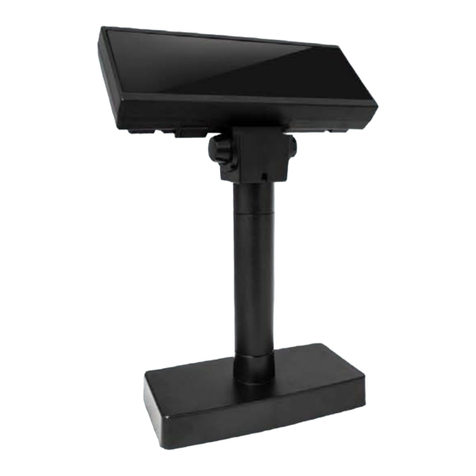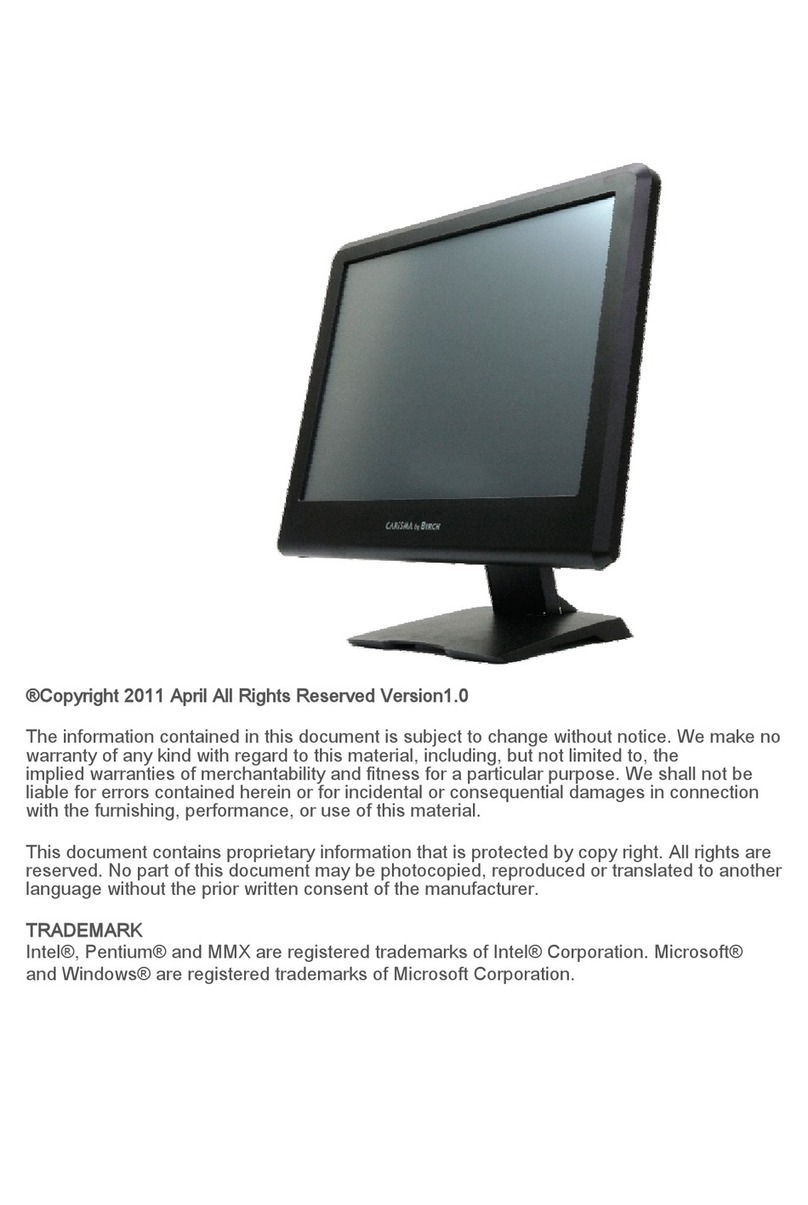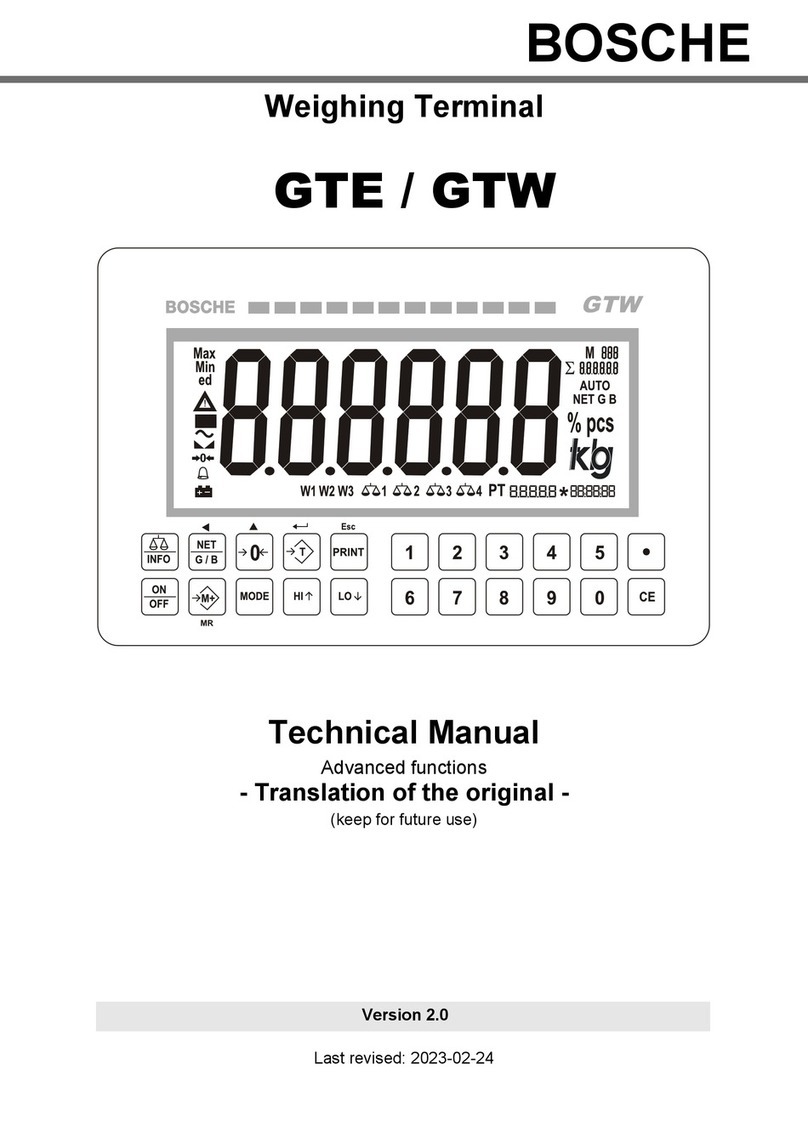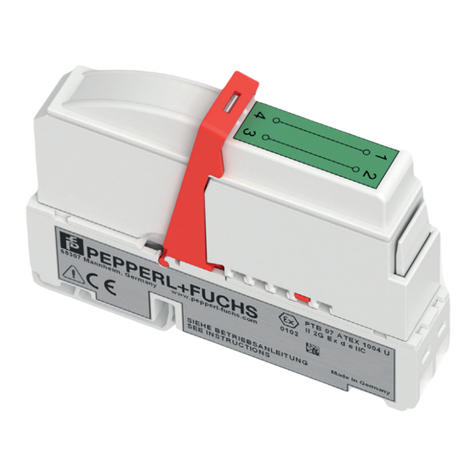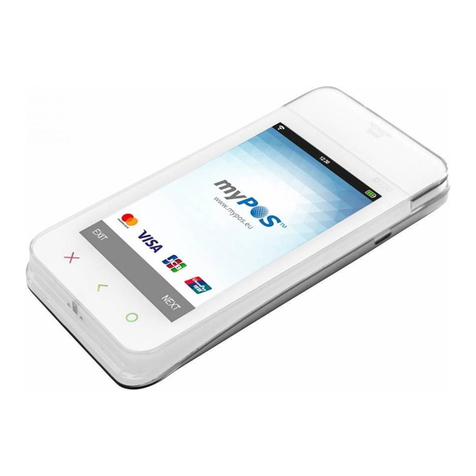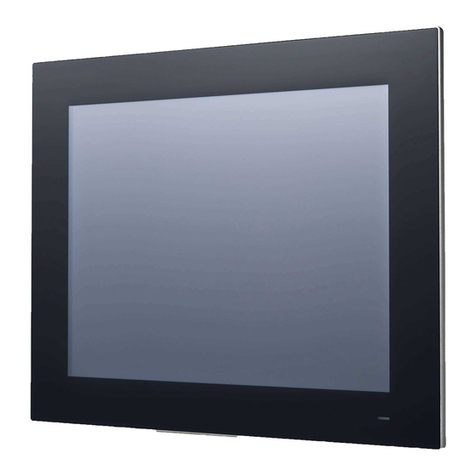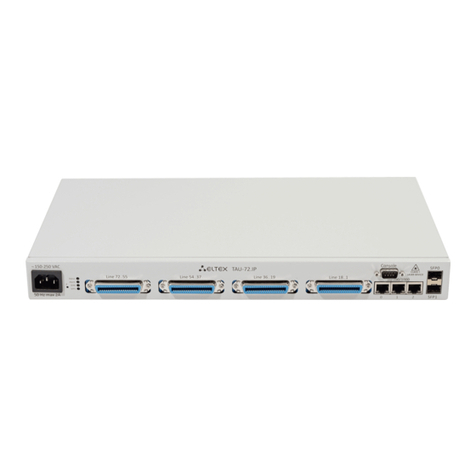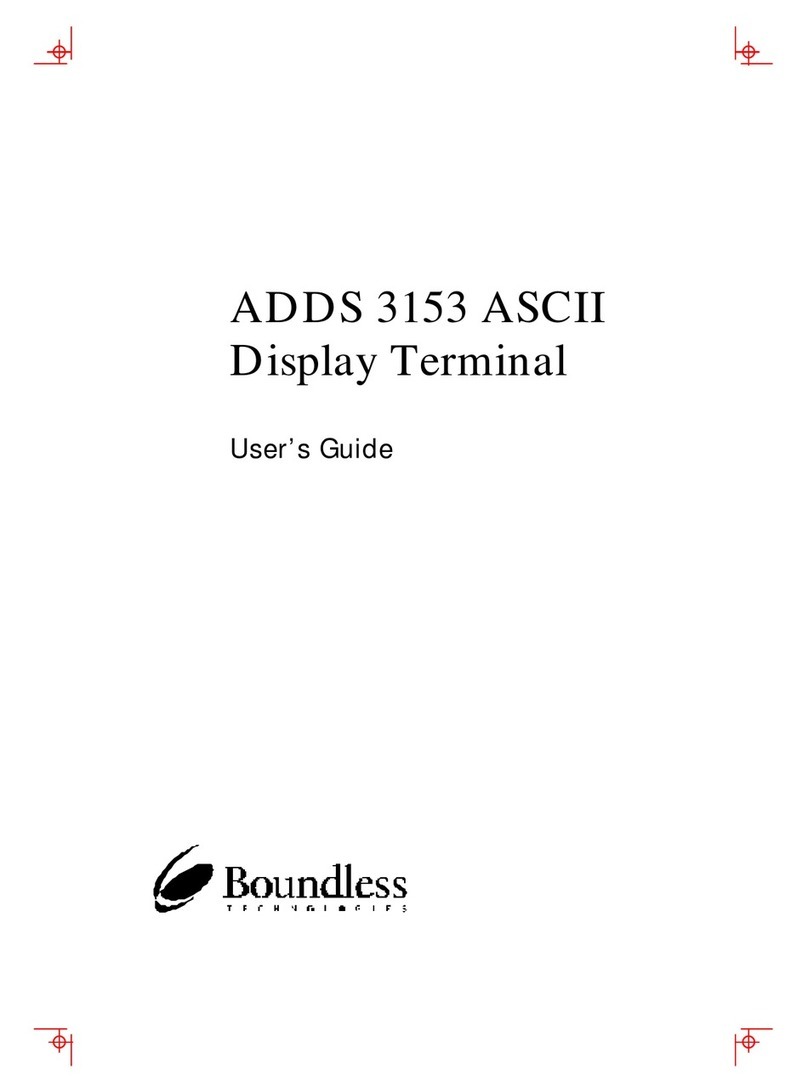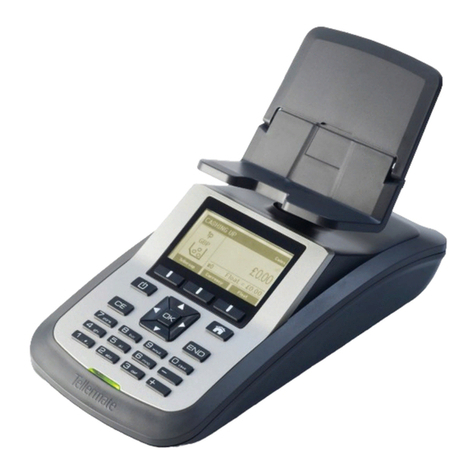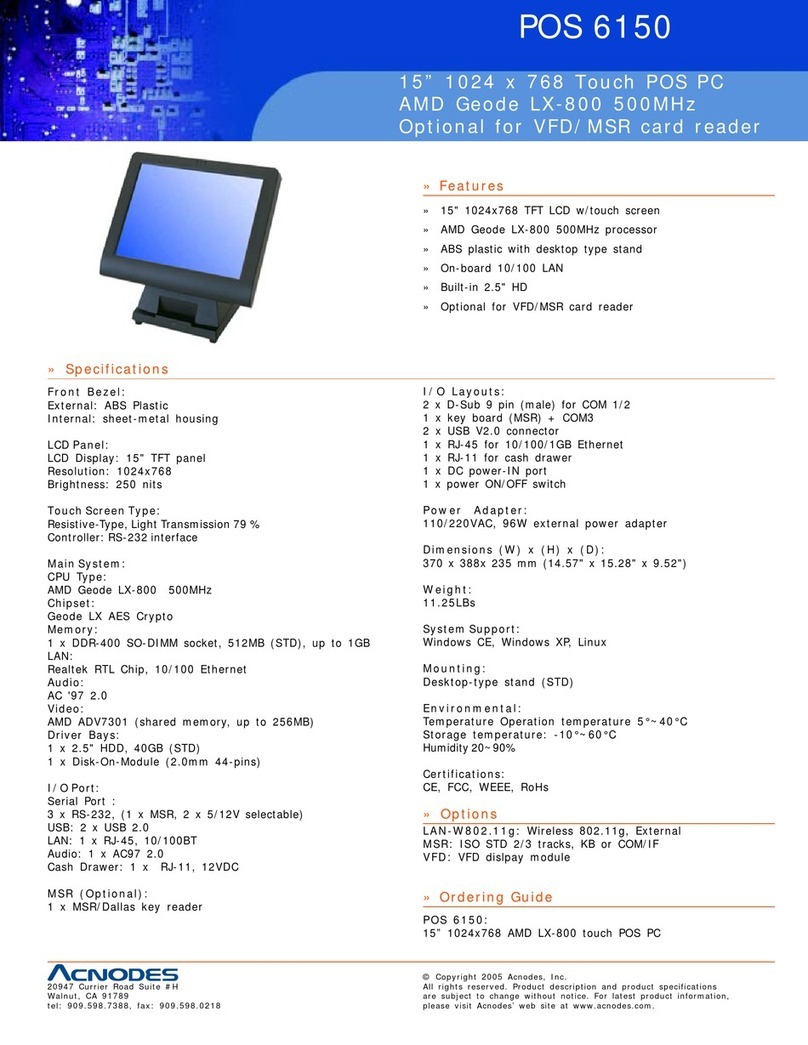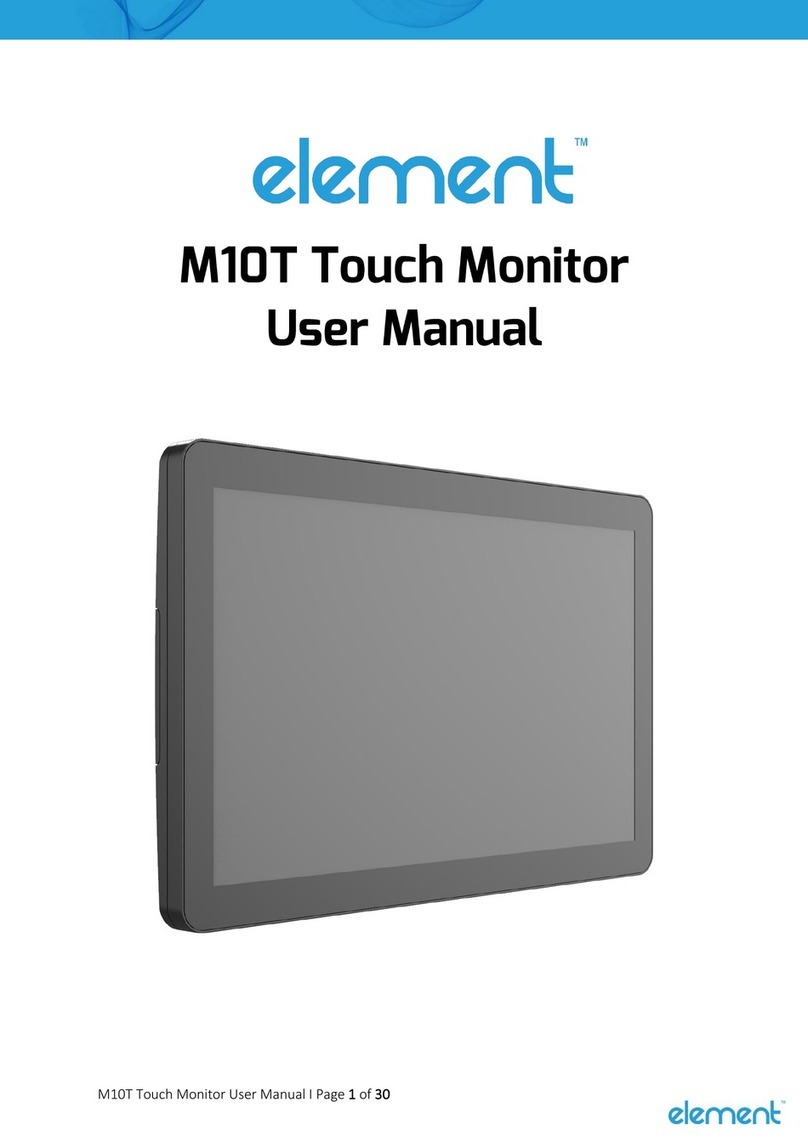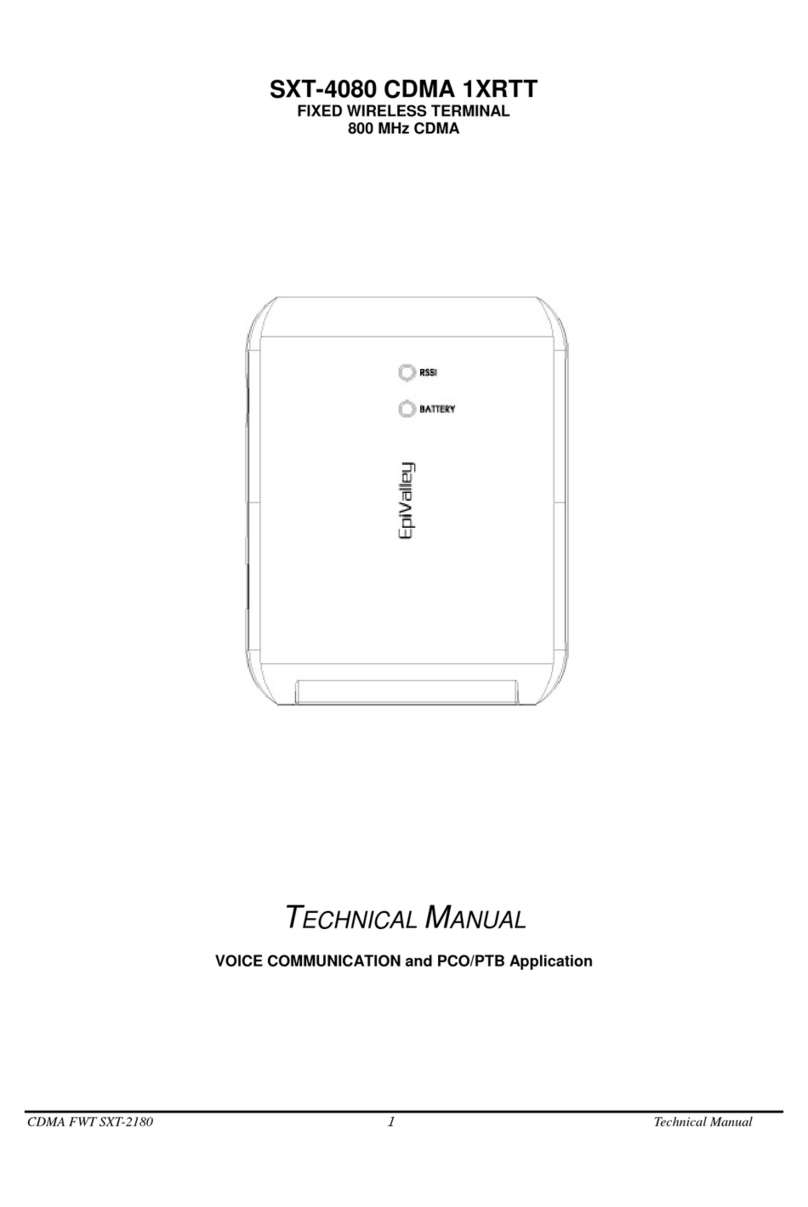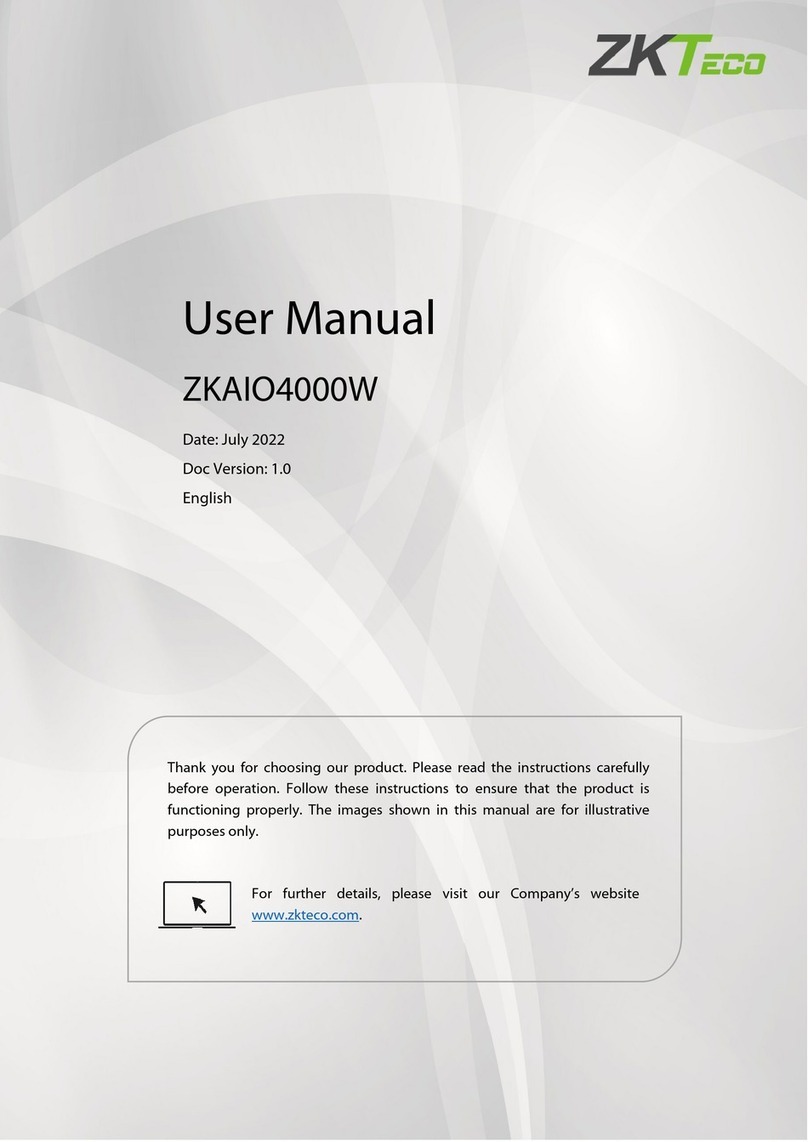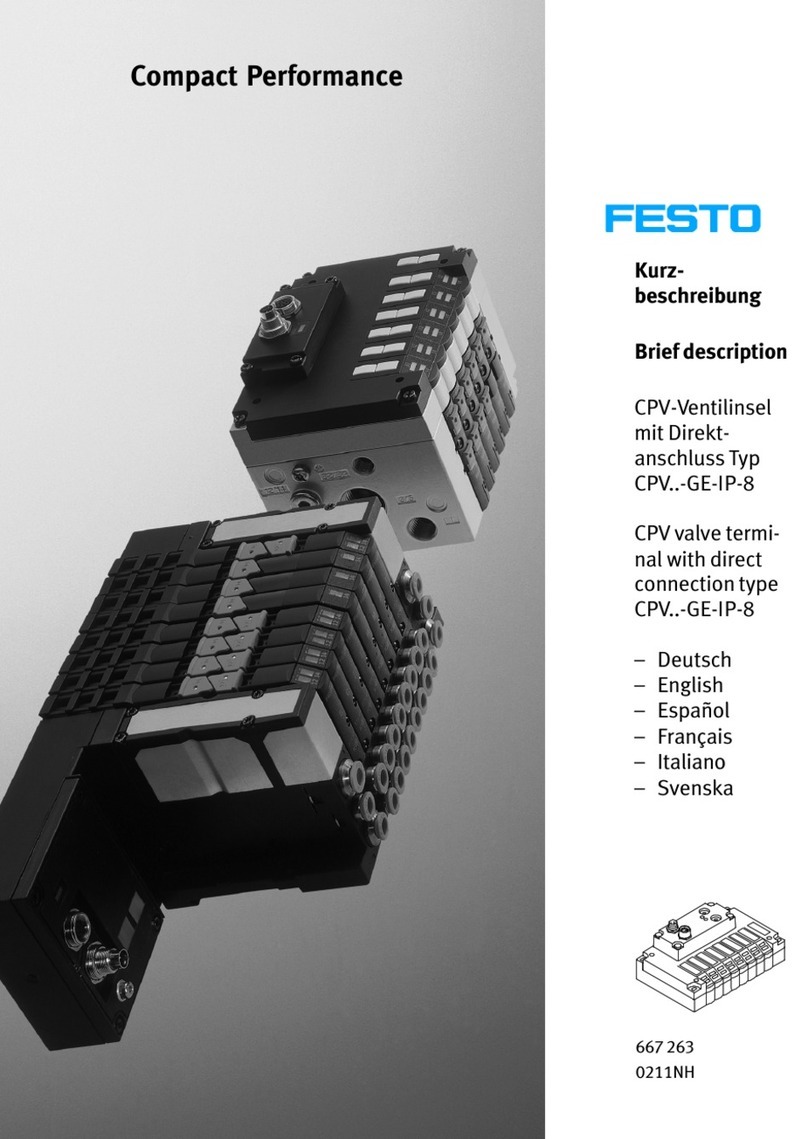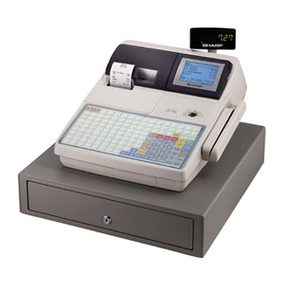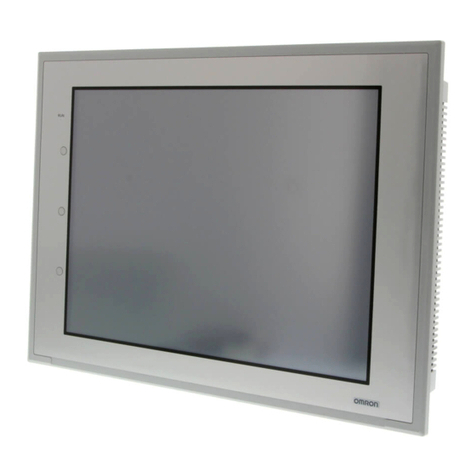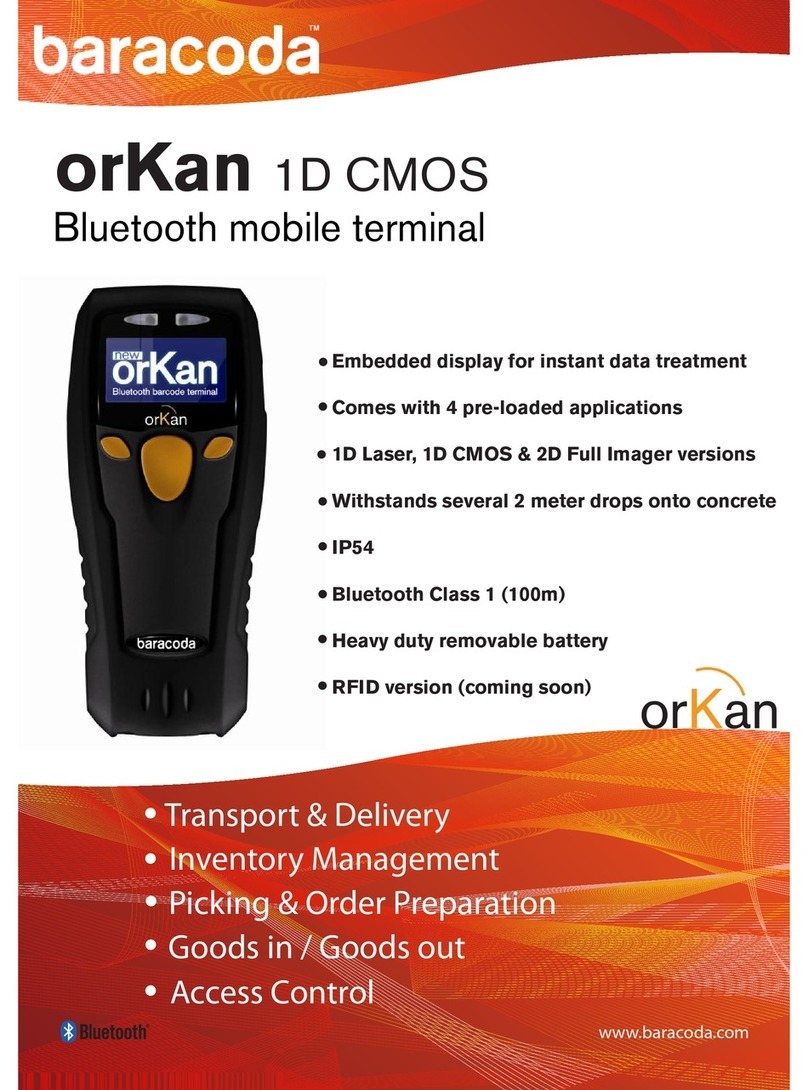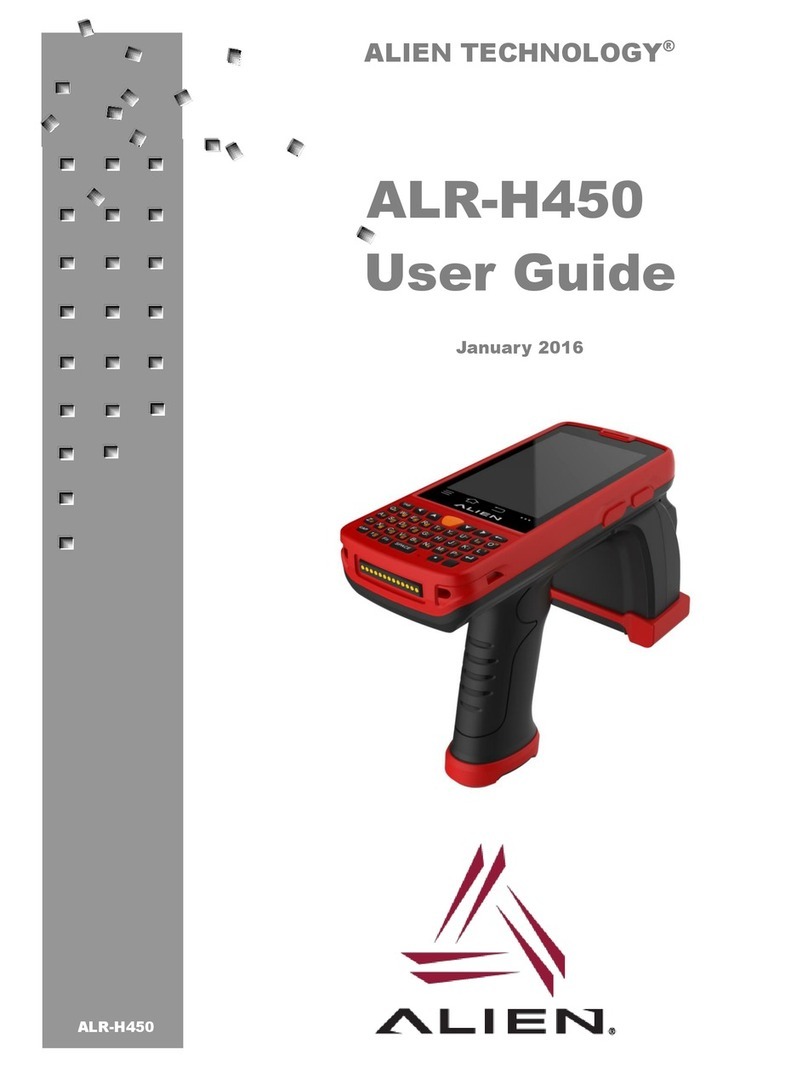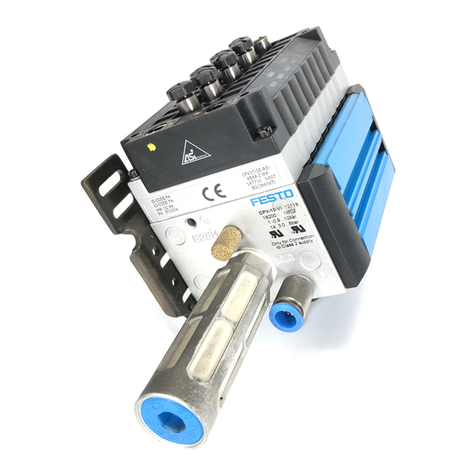Birch BCP-760 User manual

BCP-760 Portable Terminal
Operation Guide
Birch Technology Inc.
www.birch.com.tw

BCP-760 Operation Guide Page 2 of 31
CONTENTS
CHAPTER 1. INTRODUCTION ....................................................................................................................................................... 3
1.1PROGRAMMING................................................................................................................................................................................3
1.2SUBSYSTEMS...................................................................................................................................................................................3
1.2.1 Keypad Subsystem.............................................................................................................................................................4
1.2.2 Display Subsystem.............................................................................................................................................................4
1.1.1 Serial Port Subsystem ....................................................................................................................................................... 4
1.1.2 Real Time Clock Subsystem .............................................................................................................................................. 4
1.1.3 Bar Code I put Port ........................................................................................................................................................ 4
1.3DIAGNOSTICS AND POWER-ON-TEST..................................................................................................................................................4
CHAPTER 2. SYSTEM SOFTWARE ORGANIZATION .............................................................................................................. 5
1.4APPLICATION MODULE ....................................................................................................................................................................5
1.5KERNEL MODULE............................................................................................................................................................................5
1.6OPERATION FLOW............................................................................................................................................................................6
CHAPTER 3. OPERATING MODES ............................................................................................................................................... 8
1.7KEYBOARD MODES --- USING BCP-760 S KEYBOARD........................................................................................................................8
3.1.1 NORMAL mode ................................................................................................................................................................. 9
3.1.2 COMMAND mode ............................................................................................................................................................. 9
3.1.3 ALPHA mode .................................................................................................................................................................... 9
1.8BCP-760 MODES OF OPERATION.....................................................................................................................................................9
3.1.4 Ready Mode ...................................................................................................................................................................... 9
3.1.5 User Mode ....................................................................................................................................................................... 10
3.1.6 Supervisor Mode ............................................................................................................................................................. 14
CHAPTER 4. HARDWARE OVERVIEW ..................................................................................................................................... 23
1.9INTRODUCTION ...................................................................................................................................................................23
1.10FEATURES............................................................................................................................................................................23
4.3I/O PORTS...................................................................................................................................................................................23
4.3.1 The BCP-760 has three i terface ports: ........................................................................................................................ 23
4.3.2 Sca er ........................................................................................................................................................................... 24
4.3.3 BCP-760 CHARGING/COMMUNICATION CRADLE ................................................................................................. 24
CHAPTER 5. COMMUNICATION ................................................................................................................................................ 25
1.11INSTALLATION....................................................................................................................................................................25
1.12DOWNLOADING AND UPLOADING................................................................................................................................26
5.1.1 Dow loadi g a file from Host to BCP-760 usi g the Kermit Server ............................................................................. 26
5.1.2 Uploadi g files from BCP-760 to HOST usi g the Kermit Server ................................................................................. 27
CHAPTER 6. TROUBLESHOOTING ............................................................................................................................................ 28
CHAPTER . POWER SOURCES .................................................................................................................................................. 29
1.13MAIN/BACKUP BATTERY REPLACEMENT AND INSTALLATION............................................................................30
1.14MAIN POWER BATTERY CHARGING WITH AC/DC ADAPTOR (REGULAR/NORMAL CHARGE)......................................31
1.15MAIN BATTERY CHARGING WITH CRADLE................................................................................................................31
1.16MAIN BATTERY STORAGE & SAFETY PRECAUTIONS..............................................................................................31

BCP-760 Operation Guide Page 3 of 31
Chapter 1.Introduction
The BCP-760 is a programmable and flexible data collection device that can be utilized in a variety of data
acquisition applications. It can be used as a portable data entry device and it can also be used as a
programmable dedicated computer that receives and runs application programs downloaded from a host
computer.
The BCP-760 is controlled by a 16-bit INTEL 8088 compatible microprocessor, and has a 256K user
programmable FLASH MEMORY that includes a rich set of DOS functions and device drivers for application
development, including bar code decoding, display, keypad, communications, and real time clock/calendar.
BCP-760 BLOCK DIAGRAM
┌────────┐
│Lithium │
┌─────────┐ │Battery │
│ 128x64 │ └───┬────┘
│ bit map │ ┌────┴─────┐
├─────────┤ ┌──┴────┐ ┌──┴───┐
│ Graphic │ ┌──────────┐ ┌───────┐ │RAM │ │ Real │
│ LCD │ │ 25 K │ │1 -bit │ │2.5M- │ │ Time │
│ Driver │ │ Flash ROM│ │ CPU │ │ 4.5MB │ │ Clock│
└───┬─────┘ └────┬─────┘ └───┬───┘ └──┬────┘ └──┬───┘
│ │ │ │ │
═══════════════════════╧╤═════════════╧═╤═══════════╧════╤════╧══════════╧════
│ │ │
╔═╦═╦═╗ ┌───┴────┐ ┌────┴─────┐ ┌────┴─┬────────────┐
Keypad ╠═╬═╬═╬═══╡ Key │ │ RS-232 │ │ Bar │ Integrated │
╠═╬═╬═╣ │ Matrix │ │ Serial │ │ Scan │ Laser Diode│
╚═╩═╩═╝ └────────┘ └──────────┘ └──────┴────────────┘
The BCP-760 can be purchased with 2.5MB or 4.5M on-board RAM. All RAM memory is powered by the
main Li-ion battery and a back-up lithium battery, which retains the data stored in RAM and real time clock
when the main battery is drained. The BCP-760 has a 128x64 pixel backlit graphic LCD display, an integral
27-key keypad, a built-in bar code laser scanner/CCD module and an RS-232 serial port for data
communication with a host PC.
1.1 Programming
The BCP-760 system kernel includes three basic modules: 1. Device driver, 2. File manager and 3.DOS
manager. The BCP-760 terminal can be programmed using an E-PROM resident application program called
FormBuilder, Microsoft C, Borland C, Turbo C, Turbo Pascal and IBM PC macro assembler. The ROM
based firmware of the terminal provides emulated MS/DOS function calls. The programmer can design the
application programs by calling those functions just like in a DOS environment. The calling and parameter
passing conventions are compatible to that of MS/DOS and the programs are in the EXE format.
Programming details are included in the BCP-760 programming manual in these technical manuals.
The intelligence level of the terminal is determined by the configuration of the FormBuilder application or
supported language compiler. Once the program has been started up, the terminal operates as a stand-alone
unit, storing transaction data in the RAM disk area or linked to a host/personal computer.
1.2 Subsystems
The following describes several subsystems and related I/O interface functions, the DOS manager and file
manager functions. Detailed calling process is explained in the Programming Reference Guide included in
these technical manuals.

BCP-760 Operation Guide Page 4 of 31
1.2.1 Keypad Subsystem
The keypad subsystem scans the key matrix, converts the scan code to its associated key value and stores the
value in the keyboard input buffer for program utilization. The table below shows hexadecimal values assigned
to each key.
KEY VALUE KEY VALUE KEY VALUE KEY VALUE KEY VALUE
CLR 08H -2DH =3DH M4DH Y59H
ENTER 0DH .2EH ?3FH N4EH Z5AH
10H /2FH @40H O4FH [5BH
11H 030H A41H P50H \5CH
↓12H 131H B42H Q51H ]5DH
↑13H 232H C43H R52H F1 86H
SP 20H 333H D44H S53H F2 87H
!21H 434H E45H T54H F3 88H
#23H 535H F46H U55H F4 89H
$24H 636H G47H V56H F5 8AH
%25H 737H H48H W57H F6 8BH
&26H 838H I49H X58H F7 8CH
*2AH 939H J4AH Y59H F8 8DH
+2BH :3AH K4BH Z5AH EXIT 84H
,2CH ;3BH L4CH [5BH
1.2.2 Display Subsystem
The BCP-760 display subsystem supports a character oriented 8-line by 20-character or 4-line by 16-
character LCD display. The origin (0,0) is always at the top-left hand corner. This subsystem provides the
program interface functions to display characters, set cursor position, get cursor position and clear screen
display.
1.1.1 Serial Port Subsystem
The BCP-760 terminal has an RS-232 serial port for data communication. The communication subsystem
consists of point-to-point protocol for general processing. The BCP-760 also supports a built-in Kermit server
for point-to-point communication.
1.1.2 Real Time Clock Subsystem
This subsystem allows users to set and obtain system date and time from the Real Time Clock Integrated
Circuit (IC) in the BCP-760.
1.1.3 Bar Code Input Port
The BCP-760 has a built-in barcode decoder. The terminal reads bar code labels through an integrated laser
scanner module or CCD module.
1.3 Diagnostics and Power-On-Test
The system diagnostic routines exercise the ROM validity check, test the RAM, system parameters, the keypad,
the real time clock, the RS-232 port, LCD and scanner port. The power-on-test is a subset of the system
diagnosis that only includes the ROM validity check, system parameter check sum test, and back-up battery
level check.

BCP-760 Operation Guide Page 5 of 31
Chapter 2.System Software Organization
The BCP-760 system software is organized into two modules: the kernel module and the application module
(see diagram below).
MODULE ORGANIZATION
┌──────────────────────────────────────────────────────────────────┐
│ ┌───────────┐ | ┌──────────────────┐ │
│ APPLICATION │Terminal │ | │ Downloadable │ │
│ MODULE │module │ | │ Application │ │
│ └───────────┘ | └──────────────────┘ │
│ ┌───────────┐ | ┌──────────────────┐ │
│ │Workstation│ | │ Downloadable │ │
│ │module │ | │ Application │ │
│ └───────────┘ | └──────────────────┘ │
│ ┌───────────┐ | ┌──────────────────┐ │
│ │User-device│ | │ Downloadable │ │
│ │module │ | │ Application │ │
│ └───────────┘ | └──────────────────┘ │
│ RESIDENT APPLICATIONS | TRANSIENT APPLICATION │
│ | │
╞══════════════════════════════════════════════════════════════════╡
│ ERNEL ┌──────────┐ ┌────────────┐ ┌──────────┐ │
│ MODULE │ SCAN_INT │ │ KEYPAD_INI │ │ COM_INI │ │
│ └──────────┘ └────────────┘ └──────────┘ │
│ ┌──────────┐ ┌────────────┐ │
│ │ EXEC │ │ LOADER │ │
│ └──────────┘ └────────────┘ │
│ ┌──────────┐ ┌────────────┐ ┌──────────┐ │
│ │ DOS │ │ FILE │ │ COM │ │
│ │ Manager │ │ Manager │ │ Manager │ │
│ └──────────┘ └────────────┘ └──────────┘ │
└──────────────────────────────────────────────────────────────────┘
1.4 Application Module
Although applications run on the BCP-760 are classified into resident and transient categories, the BCP-760
operation cannot decipher the difference between them. The only difference is the location of the executable
files. For resident applications, the Job Scheduling EXEC "jumps" to the entry point in the EPROM and begins
execution. For transient applications EXEC "loads" the executable file from the RAM file into the RAM
memory and then begins execution.
1.5 Kernel Module
The BCP-760 kernel provides basic system services. The kernel module includes the DOS Manager, File
Manager, COM Manager and several interrupt service routines.
DOS Manager The DOS manager emulates most MS DOS function calls to control BCP-760 peripherals
and files.
FILE Manager The File manager implements a DOS-like file subsystem to support essential file operations.
COM Manager The COM manager controls the communication link between the BCP-760 and the host
through a RS232 serial port.
LOADER The function of the loader is identical to that of the MSDOS loader except for the memory
allocation/deallocation scheme being simplified. The loader's operations are:
1. read .exe header
2. find enough memory for .exe
3. read binary into RAM
4. relocation based on RAM allocation
5. set up all registers

BCP-760 Operation Guide Page 6 of 31
6. jump to the entry point
LCD Manager The LCD manager handles the cursor positioning and graphic pattern display. Two
character pattern fonts are supported. BCP-760 can support both 6x8 font (20 column by 8
lines) and 8x16 font(16 column by 4 line).
EXEC The EXEC is the job scheduler. It manages top-level operation flow of the BCP-760 system.
The EXEC program is analogous to the COMMAND.COM program in MS DOS-based
machines.
1.6 Operation Flow
The EXEC program controls the BCP-760. When the portable terminal is powered up, EXEC performs the
power-on-test (POT). EXEC proceeds to verify if the BCP-760 should make a warm or cold booting. A warm
boot resets the system without clearing any RAM program or data files. Device configurations preserve the
same values as they had before the warm boot. On the other hand, a cold boot will clear the RAM and
initialize the BCP-760 to default values.
The BCP-760 is always testing its main and backup batteries. The LCD will display a warning message when
the test fails.
Power on Test Test failure message
Main battery test "WARNING MAIN BATTERY LOW"
Backup battery test "WARNING LITHIUM BATTERY LOW"
When the main battery is low, a warning message will be displayed on the LCD when BCP-760 is power on.
For BCP-760, it can automatically detect battery status, a warning sign will be display on battery icon on the
upper side of LCD.
During the start-up process, EXEC also initializes the BCP-760 barcode scanner and RS232 communication
port, and creates all dynamic data structures; e.g. keypad queue and COM buffer. Once the initialization
procedure has been completed, EXEC checks if a supervisor menu has been requested. The supervisor menu
can be requested if the operator holds down both [CMD] and [] keys while powering up the BCP-760.

BCP-760 Operation Guide Page 7 of 31
START FLAG
SAVE NOT OK
RESUME?
READY mode
System Recover
POWER ON
NO
NO
NO
YES
NO
error?
error?
AUTOEXEC.e e
e isted?
<<START MENU >>
1.SUPERVISOR
2.WARM START
WARM START
press [2]
Supervisor mode
Disabled?
press [1]
SUPERVISOR mode
YES
NO
NO
AUTOEXEC.e e
run
YES
YES
YES
while pressing [PWR]
Press [CMD] & [<]
simutaneously
YES
WARNING !
DELETE ALL DATA
Are you sure?
(YES/NO)
press [3]
COLD START
press
press
USER mode
press [CMD] and
hold down for 2 seconds
3.COLD START
NO]
Yes]
NOTE: 1) Cold start, will clear all data stored in the RAM and reinitialize the portable terminal to
system default.
2) There are two system flags, “Start” flag and “Save NOT OK” flag, which will be verified
each time the unit is turned on.
3) When the “Start” flag verification fails, it indicates that there is probably a defective RAM
chip or that the backup battery power is low. A data back up and hardware diagnostics are
recommended in these cases.
4) The “Save NOT OK” flag is used to check if the previous turn-off process was made
normally or not. The system will not return to the last turn-off point if the “System Resume”
is set to On when this flag verification fails.
A program downloaded to the BCP-760 may be automatically executed each time the portable terminal is
turned on. In order for the program to be auto-ran, it must be downloaded to BCP-760 with the name
AUTOEXEC.EXE. When the BCP-760 is turned on, the system will scan the file directory and execute the
program, otherwise it will enter a mode of operation called the READY mode. In this mode, the BCP-760
will standby for keypad-entered commands, or commands from the Host PC.

BCP-760 Operation Guide Page 8 of 31
Chapter 3.O ERATING MODES
1.7 Keyboard Modes --- Using BCP-760’s keyboard
The keypad of BCP-760 consists of 27 rubber keys, the ⊙key is used to switch on/off the unit and other 26 keys are
used to control the unit and key in data. The use of keyboard is categorized to three modes: normal mode, command
mode, and alpha(betic) mode. All keys except ⊙key may produce a sound (tone) when pressed. Keys of upper four
rows have larger size for easier key-pressing to input numbers.
[⊙] When the unit is off, pressing the ⊙key will turn on the unit. On the other hand, when the unit is on it is
needed to press and hold down the ⊙key for about one second in order to turn the unit off.
[CMD] Pressing the [CMD] key sets the keyboard to Command mode. However pressing and holding down the
[CMD] key for two seconds in Ready mode will enter the User mode. In User mode, users can invoke
system commands by menu selection.
[CMD] then [Alpha] In User mode or Supervisor mode, pressing the [CMD] key and then pressing [ALPHA] key
will exit from the current operation to the previous operation.
NORMAL
mode
COMMAND
mode AL HA
mode
press [CMD]
press [CMD]
press [ALPHA]
press [ALPHA]
press [CMD]
press [ALPHA]

BCP-760 Operation Guide Page 9 of 31
3.1.1 NORMAL mode
Keyboard of the BCP-760 is initialized to normal mode after powered on. In normal
mode, the cursor is a block sign and the keyboard is mainly used to input numeric
data and use F1-F4 four function-keys. The keypad layout of available keys in
normal mode is shown on right picture.
→key for next data search
←key for last data search
3.1.2 COMMAND mode
Press [CMD] key sets the keyboard to command mode. In command mode, the cursor
type keeps same and the keyboard is mainly used to input special characters, make hot-
key function, and use F5-F8 four function-keys. The keypad layout of available keys on
command mode is shown on right picture. There are three hot-key functions and the
usage of each function is described below.
LCD Backlit On/Off : Hit []Key to toggle between ON and Off.
LCD Contrast :Press and hold down [] key to continuously change
from light to dark.
Buzzer Volume : Hit [SP] key to toggle among Mid, Hight and None
3.1.3 ALPHA mode
Press [ALPHA] key to toggle between normal mode and alpha mode of keyboard In alpha mode, the cursor is an
underscore sign and the keyboard is available to input upper case letters. In alpha mode, every numeric key contains 3
characters individually. Pressing the key to choose among three available characters.
For example :
First press [ALPHA] to switch the system to alpha mode, the cursor type will be changed from
block to underscore
To enter ‘A’, hit [7] one time
To enter ‘B’, hit [7] twice.
To enter ‘C’, hit [7] three times.
1.8 BCP-760 Modes of Operation
There are three modes of operation in the BCP-760:
a. Ready Mode
b. User Mode
c. Supervisor Mode
c
3.1.4 Ready Mode
The Ready mode is the default resident operating mode. In the Ready mode the BCP-760 is configured as a
portable programmable device, and is capable of receiving files (Download) from or transmitting files (Upload)
to a Host PC. Data files or recorded information collected from the BCP-760 are uploaded to the host
whenever the host program is ready to receive the collected data. Some applications may also require prepared
data files (e.g. database information). These data files are loaded to the BCP-760 in the same manner as
application programs are downloaded. The BCP-760 carries out upload and download operations through its
SPACE
Clear
Enter
Backlit
Contrast
Buzze

BCP-760 Operation Guide Page 10 of 31
built-in RS232 port. The operator can later select one of the executable applications to run in the portable
terminal via the keypad or host command sequence.
After the Warm Start, the BCP-760 enters the Ready mode and shows the Ready mode screen as shown left.
The first line indicates the model code and BIOS firmware version number. The second line shows the size of
the installed RAM. The third line shows the prompt, ">" which indicates that the terminal passed the Power-
on-test and is in the Ready mode of operation.
Ready Mode User mode menu
Press and Hold down [cmd]
Key for two second
Press [CMD] then [Alpha]
3.1.5 User Mode
The User Mode allows the operator to issue commands to the BCP-760. Pressing and holding down the [CMD]
key for two seconds while in the Ready Mode will invoke the User Mode (see figure below). There are eight
commands: 1.RUN, 2.TER, 3 COM, 4.DIR, 5. ERA, 6.TYP, 7.CPY, and 8.SET. Select the corresponding
number, 1-8, or press [] and [] to move cursor then press [ENT] to select and issue the desired command
to the BCP-760. Pressing [CMD] then [Alpha] key will return the system to the Ready Mode.
BCP-710 V1.50
MEM 2500 KB 1.RUN 2.TER
3.COM 4.DIR
5.ERA 6.TYP
7.CPY 8.SET

BCP-760 Operation Guide Page 11 of 31
User Mode Commands:
Command
Usage
RUN Runs the selected executable program
TER Terminal emulation mode or FormBuilder operation
COM Kermit server mode
DIR Display RAM disk file directory
ERA Delete a file from RAM disk
TYP Dump the content of a file to the LCD
CPY Copy data from a device/file to another device/file
SET Set real time clock, scanner type and power-on logo
1.8.1.1 RUN
After a program is downloaded to the hand held unit, the user may invoke the
RUN command and press [→] key to display the executable files stored in
memory, then press [ENT] to run the program. Pressing [CMD] then [Alpha] and
then pressing any key will return the BCP-760 to the User Mode menu.
1.8.1.2 TER
The TER command puts the BCP-760 in either Terminal Emulation operation or FormBuilder operation. User
will need to choose when the TER was selected and the BCP-760 execute the operation.
Terminal Emulation Operation. When EXEC transfers control to this EPROM-resident application program,
the BCP-760 operates as a dumb ASCII terminal while exchanging data with a Host computer. Data input from
scanning bar code labels or key-press will be sent to the portable terminal RS-232 port. In order to carry out a
successful file transfer, communication parameter setting such as baud rate, data bits, parity, stop bits and flow
control, must match the setting at the Host end. Data received from the serial port is displayed on the LCD
screen.
The functionality of the BCP-760 in terminal mode depends on the format configured in the Terminal Control
Table. The BCP-760 is either configured as free format processing or forms based processing. The BCP-760
examines the "data buffer" and determines if host data transfer is required. If a terminating condition exists by
the reception of a terminating character, the BCP-760 outputs the buffer to its RS232 port. Data transfer
between the host machine and the BCP-760 is primarily controlled by the terminating conditions specified in
the Terminal Control Table.
In the terminal application, the program further distinguishes the character mode communication from block
mode communication. Character mode communication dictates that the BCP-760 sends every key (one at a
time) to the host. Normally character mode communication uses None protocol, otherwise there will be an
overwhelming protocol overhead. The input character may come from the keypad or barcode scanner,
whichever comes first. Data characters sent over from the host system will always be displayed on the LCD
screen. Host control commands, which have a special command header (ESC), will not be displayed on the
LCD. The host commands are interpreted by the BCP-760 as they are received.
Block mode applications perform similar functions to character mode, except that the input characters will not
be sent to the host one character at a time. Instead the BCP-760 holds the data in its internal buffer until a
termination character is received. Specifying parameter linepage, lineterm, and pageterm in the terminal control
table programs the termination character. The BCP-760 allows at most two termination characters.
FormBuilder Operation. When EXEC transfers control to this EPROM-resident application program, it
allows the user to create a data entry application program by simply specifying field prompt, type, length, input
< RUN PROGRAM >
Filename:
NULL

BCP-760 Operation Guide Page 12 of 31
method and delimiter, etc. without having to write a comprehensive application program. FormBuilder is
enabled or disabled while the BCP-760 is in the Supervisor mode of operation.
1.8.1.3 COM
The COM command activates the BCP-760 Kermit server. Pressing [CMD] then [Alpha] returns the BCP-760
to the User Mode of operation. The following list shows the available Kermit commands in the Host/PC:
Command Description
SEND program Sends a file from the Host/PC to the BCP-760 and
stores it in the BCP-760's RAM disk.
GET data Gets a collected data file from the BCP-760 to the Host/PC disk.
REMOTE DIR Lists BCP-760 RAM disk file directory.
REMOTE DEL filename Deletes a program or data file from the BCP-760 RAM disk.
BYE Exit Kermit Mode
Before making use of the Kermit server, switch the BCP-760 to the Supervisor mode and set the BCP-760
communication parameters to match the host/PC system. See Section 3.2.3.1 Device Configuration.
1.8.1.4 DIR
The DIR command shows RAM disk file directory with the following information:
The list of file names stored in the RAM DISK.
The amount of memory assigned to executable programs (Execution Area).
The amount of free RAM DISK space left. (FREE DISK)
Press [ENT] to exit this screen and return to the User Mode menu.
1.8.1.5 ERA
The ERA command allows the user to delete file by pressing [] or [] key to
select an existence file then pressing [ENT]. When the selected file has been
deleted, it cannot be recovered. Press [CMD] then [Alpha] key to abort the ERA
command and return to User Mode Menu.
1.8.1.6 TYP
The TYP command dumps the contents of a file to the BCP-760's LCD. If the
user tries to display a program or binary file, only unintelligible characters will be
seen. When selecting the TYP command, the BCP-760 allows the user using []
or [] key to select an existence file then pressing [ENT]. The screen will display
160 (20 character x 8 line) characters at a time. Press any key to show the next page or press [CMD] then
[Alpha], to warm start the BCP-760 and return to the Ready Mode.
1.8.1. CPY
The CPY command allows the user to make a copy of data from a source and transfer the information to
destination. The source and destination can be a file or devices, such as COM, serial port or CON. The CON
specifies LCD for destination and keyboard for source.
Source Destination Function
Valid file1 file2 copy file1 to file2
MYPRG.EXE
ITEM.DAT
<<END>>
2 File(s)
< ERASE FILE >
Filename:
█
< TYPE FILE >
Filename:
█

DATE-TIME SETUP
1998/01/01
08:00:00
BCP-760 Operation Guide Page 13 of 31
Source/ file1 COM output content of file1 to serial port
Destination file1 CON output content of file1 to LCD
Combination COM file2 input data from serial port and store in file2
CON file2 input data from keyboard and store in file2, pressing [CMD] then
[Alpha] to end the data input
1.8.1.8 SET
The SET command allows the user to set system date-time, select type of bar
code scanner, assign laser module scanning method and enable double
verification. Select the corresponding number, 1-4, to invoke a function. Pressing
the [CMD] and then the [Alpha] key returns the portable terminal to the User
Mode menu.
1.8.1.8.1 DATE & TIME Set System Clock/Calendar
By selecting “1.DATE & TIME” in the SET menu, you can set the BCP-760 date and time. The date and time
can be used as the time stamp to be appended to an input data record by an
application program. The second line shows the current system date in the format
YYYY/MM/DD (year/month/day). For instance, 1998/01/01 indicates that date is
January 1, 1996. If you want to reset the system date to August 31, 1997, then enter [1],
[9],[9],[7],[0],[8],[3],[1]. Or press the [ENT] key to skip the system date setting.
The third line shows the current time. The setting method is similar to setting the date. The time is expressed
in the 24-hour system in the format HH:MM:SS (hours:minutes:seconds).
1.8.1.8.2 SCANNER
SCANNER The bar code input interface of the BCP-760 is compatible to all major bar code scanners
that are available in the market including wand, CCD and laser diode scanners. Use the []
key to toggle among ENABLE and DISABLE, then press [ENT].
LASER TRIG MODE : User can select whether pen is activate to read barcode label by one trigger/one
scan or flash scan.
If it is set NORMAL, laser beam will be emitted to scan barcode and it will stop laser
beam after successfully scan barcode. User need to release trigger key and then press again
to scan next label.
If it is set to FLASH, user just press trigger and then release it, then scanner will
automatically scan barcode. When it successfully read a barcode, scanner will continuously
emit laser beam to read next label. User can press trigger again to stop automatic scanning.
LASER AIM When BCP-760 is equipped with SE1200LR engine, user can use this setting to activate
aim beam before starting scanning barcode. It will be helpful for user to focus target
barcode label. Use the [] key to toggle among ENABLE and DISABLE, then press
[ENT].
VERIFICATION When label quality is not good, and then cause error decoding. You can enable this
function to let BCP-760 double verification input barcode. When it is set ENABLE,
BCP-760 read barcode label twice to compare if it read the same data.
1.8.1.8.3 DISPLAY
Enable/Disable whether to show the Power-on LOGO.
Power-on LOGO enabled is the default setting.
1.8.1.8.4 KEYPAD:
<SYSTEM SETUP>
1.DATE & TIME
2.SCANNER
3.KEYPAD
4.EXIT

BCP-760 Operation Guide Page 14 of 31
Setup up-case and low-case Alpha character input
User can define upper-case or lower-case input on Alpha mode.
3.1.6 Supervisor Mode
The BCP-760 Supervisor mode allows the user to configure and validate the BCP-760 hardware. To switch
the BCP-760 to the Supervisor mode of operation do the following:
1. Turn off the BCP-760.
2. Press and hold down the [CMD] and []keys simultaneously, then switch on the BCP-760 by pressing
the [⊙]key. The BCP-760 LCD first shows the ‘START MENU” where the user has three (3) choices:
1.Enter the Supervisor mode, 2.Command the BCP-760 to execute a Warm Start, 3. Command the
BCP-760 to execute a Cold Start.
After selecting 1, a password entry is requested from the user to prevent unauthorized users from accidentally
changing configuration parameters. The system will return to the Ready mode after 5 unsuccessful tries. The
default password is “760”. The Supervisor mode menu will be shown on LCD after the correct password is
keyed-in.
The Supervisor Mode function lets the user set the following functions:
1. DEV: Device Configuration
2. TERM: Terminal Configuration
3. MEM: Memory Configuration
4. FORM: FormBuilder Define
5. PWR: Set Resume/Auto-Off/Alarm of program
6. PSWD: Password Change
7. SYS: System Initialization, update BIOS
8. DIAG: System Diagnostic
1.8.1.9 Device Configuration
When selecting the option "1.DEVICE", the LCD will offer the user 3 choices: 1)
Set the keypad input Language setting, 2) Set the serial port communication
parameters, and 3) Enable/disable supported bar code symbologies.
1.KEYPAD The BCP-760 supports several international language setting. The default language setting is
ENGLISH. Press [] or [] to select different language setting. There are Sweden/Finland,
Danish, Spanish, French, German, and Italian. Press [ENT] to confirm the setting and return to
the previous menu.
2.SERIAL The BCP-760 supports one RS232 port on flat 12 pin connector. Data can be downloaded to
and uploaded from the BCP-760 via the serial data communication port. The communication
parameters must be set correctly in order to send/receive data via the RS232 port. Default
setting for the serial port is 19200 bps,8 data bits, No parity, One stop bit
<DEVICE CONFIG>
1.KEYPAD
2.SERIAL
3.BARCODE
<START MENU>
1.SUPERVISOR
2.WARM START
3.COLD START
SUPERVISOR
MODE
PASSWORD:
1.DEV 2.TERM
3.MEM 4.FORM
5.PWR 6.PSWD
7.INI 8.DIAG

BCP-760 Operation Guide Page 15 of 31
The settings for the communication parameters include:
BCP-760
Category Selection Default
♦ Baud Rate 150, 300, 600, 1200, 2400, 4800 19200
9600, 19200, 38400, 57600.
♦ Length 7, 8 8
♦ Parity Even, Odd, None None
♦ Stop bits 1, 2 1
♦ Flow Control Xon/Xoff, CTS/RTS, None None
♦ Protocol MULTI, OFF (None) MULTI
♦ Address A~Y, 0~6 A
Press [] to select the setting, [ENT] to confirm the setting.
3.BARCODE when selecting Option 3. BARCODE in the Supervisor Mode, Device
Configuration menu, the LCD will display the BARCODE Setup as shown below.
Press [] or [] to toggle between settings. Press [ENT] to set.
Setup decoding of BCP-760 supported bar code symbologies
Symbology Setup Category (default)
Code 39 Enable/disable decoding (ON)
Enable/disable full ASCII (OFF)
Send/No-send Start/stop Character (NO SEND)
Enable/disable Check Digit Verification (OFF)
I 2 of 5 Enable/disable decoding (ON)
Enable/disable Check Digit Verification (OFF)
Codabar Enable/disable decoding (ON)
Send/No-send Start/stop Character (SEND)
Enable/disable Check Digit Verification (OFF)
UPC-A Enable/disable decoding (ON)
Send/No-send Leading Digit (SEND)
Send/No-send Check Digit (SEND)
UPC-E Enable/disable decoding (ON)
Send/No-send Leading Digit (SEND)
Send/No-send Check Digit (SEND)
Enable/disable Zero-Expansion (OFF)
EAN-13 Enable/disable decoding (ON)
Send/No-send Leading Digit (SEND)
Send/No-send Check Digit (SEND)
EAN-8 Enable/disable decoding (ON)
Send/No-send Check Digit (SEND)
<< BARCODE SETUP>>
CODE 39
ON

BCP-760 Operation Guide Page 16 of 31
EAN/UPC ADD-ON
Disable/Optional/Required (DISABLE)
Send/No-send Check Digit (SEND)
Code 128 Enable/disable decoding (ON)
EAN 128 Enable/disable decoding (ON)
Code 93 Enable/disable decoding (ON)
Code 32 Enable/disable decoding (ON)
User code 1 Enable/disable decoding (OFF)
User code 2 Enable/disable decoding (OFF)
1.8.1.10 ASCII Terminal Configuration
The TERM command enables the BCP-760 to run a built-in Terminal emulator. The BCP-760 will operate as
a dumb ASCII terminal when the user select this feature and disable the FormBuilder menu.
When the TERM SETUP menu (shown below) appears on the BCP-760 LCD, proceed to set up the portable
terminal communication parameters. When finished go to the User Mode menu and press 2 (2.TERM) to
make the BCP-760 operate as a dumb ASCII terminal.
Terminal ID Each BCP-760 "Terminal" can be identified by an 8-character string
Terminal ID assigned by the user. Initially, the default ID is
"BCP760". Valid characters for assigning Terminal ID are
alphanumeric characters ('A'-'Z', '0'-'9'). Hit [ENT] to make the
selection.
Online Use the [] key to toggle between REMOTE and LOCAL,
then hit [ENT] to make the selection.
REMOTE The BCP-760 will output data gathered from the
bar code port or keypad to its RS-232 port.
LOCAL The BCP-760 does not transmit gathered data to its RS232 port.
Echo Use the [] key to toggle between ON and OFF, then hit [ENT] to make the selection. The
collected data will be displayed on the BCP-760 LCD when Echo is set to ON, otherwise data
will not be displayed when it is set to OFF.
AutoLF Use the [] key to toggle between ON or OFF, then hit [ENT] to make the selection. When
AutoLF is set to ON, the BCP-760 will append a LF (10 hex) character to the input data block.
Mode Use the [] key to toggle between BLOCK and CHAR, then hit [ENT] to make the selection.
See section 3.2.2 for the description of Block and Character modes.
Line/Page Use the [] key to toggle among LINE, PAGE and BOTH, then hit [ENT] to make the
selection.
<<TERM SETUP>>
TERM ID.
BCP760
<<TERM SETUP>>
ONLINE
REMOTE
<START MENU>
1.SUPERVISOR
2.WARM START
3.COLD START
SUPERVISOR
MODE
PASSWORD:
1.DEV 2.TERM
3.MEM 4.FORM
5.PWR 6.PSWD
7.INI 8.DIAG
<TERM SETUP>
TERM I.D.
BCP710

BCP-760 Operation Guide Page 17 of 31
The Line/Page parameter is useful only if dumb terminal operation has been specified as
BLOCK mode. The Line/Page entry designates the termination character. The termination
character can be set as:
LINE Line termination: CR ( 0D hex)
PAGE Page termination: CTRL-Z ( 1A hex)
BOTH Line termination and page termination both.
1.8.1.11 Memory Configuration
This feature allows the user to allocate available RAM between the Execution Program and RAM disk area,
and can only be done when there is no data stored in RAM.
The RAM memory in the BCP-760 is divided into three sections:
♦System Variable About 29KB of RAM memory is reserved for BCP-760 parameters.
♦RAM Disk Area Area used to store programs and data files, similar to a physical disk of a PC.
♦Program Execution Area where the applications and data are loaded, similar to the main
Area memory in a PC.
To reallocate memory, go to the Supervisor Mode screen and press 3 (3.M_SIZE) to setup the Execution
Program Area size, key in the new memory size then press [ENT].
You can allocate available RAM between the Execution Program and RAM Disk area. The size of RAM Disk
will decrease when you increase the size of the Execution Program area, and vice versa.
The second line in the EXEC MENU shows Min and Max number of kilobytes that can be allocated to the
Execution Area.
1.8.1.12 FormBuilder Application Program
FormBuilder is a built-in application program that allows users to create a data entry application by specifying
field prompt, field length, data type, input method and delimiter, etc. without writing a program and loading it
(download or manually) to the BCP-760.
Enable the FormBuilder application by selecting 4 (4.FORM) in the Supervisor mode menu. When
FormBuilder is enabled, the BCP-760 will first ask the user to specify data fields in four categories including
field prompt, data length, and data type and device type. After defining all data fields, the user must [CMD]
then [Alpha] key to end the setup of the data field.
FormBuilder Specification
DATA FIELD DEFINITION: maximum field number=8
<START MENU>
1.SUPERVISOR
2.WARM START
3.COLD START
SUPERVISOR
MODE
PASSWORD:
1.DEV 2.TERM
3.MEM 4.FORM
5.PWR 6.PSWD
7.INI 8.DIAG
<<EXEC SETUP>
16KB – 480 KB
OLD: 240 KB
NEW: KB
<START MENU>
1.SUPERVISOR
2.WARM START
3.COLD START
SUPERVISOR
MODE
PASSWORD:
1.DEV 2.TERM
3.MEM 4.FORM
5.PWR 6.PSWD
7.INI 8.DIAG
DEFINE FIELD1
PROMPT (16 MAX)
ITEM:

BCP-760 Operation Guide Page 18 of 31
Category Range Description
1 FIELD PROMPT Max.16 characters set field prompting
2 MIN/MAX
DATA LENGTH 1-48 set minimum field length
and maximum field length
3 DATA TYPE 1.NUMERIC
2.ALPHANUM numeric data (0~9) or
alphanumeric data (20H~FCH)
4 DEVICE TYPE 1.KEY ONLY
2.SCAN ONLY
3.BOTH
input by keyboard only,
bar code scanning only or
both
DATA RECORD DEFINITION
Category Range Description
5 BETWEEN
FIELD 1.APPEND SCREEN
2.CLEAR SCREEN specify to clear or append screen
between two fields
6 FIELD
DELIMITER 1. , 2. ;
3.SPACE 4.TAB assign field delimiter
7 RECORD
DELIMITER 1.CR
2.LF
3.CRLF
assign record delimiter
8 DATE STAMP
FIELD 1.NONE 2.YYYYMMDD
3.MMDD 4.MMDDYYYY
5.DDMM 6.DDMMYYYY
assign date stamp and specify the
format of date stamp
9 TIME STAMP
FIELD 1.NONE
2.HHMM
3.HHMMSS
assign time stamp and specify
the format of time stamp
10 FIELD DELAY 0-6 specify time delay between each
record input in second
When FormBuilder is enabled, a data file named FORM.DAT will be created in the BCP-760. FORM.DAT
stores the data as entered by the user after FormBuilder is invoked. The BCP-760 will not allow the user to
redefine the data fields in FormBuilder once the FORM.DAT has been created. The file FORM.DAT must be
deleted in order to implement any change in the configuration of FormBuilder.
Running The Resident FormBuilder Application Program
Enable the FormBuilder, the BCP-760 built-in application can be ran by switching the portable terminal to the
User mode of operation and selecting “2.TER”, select “2.FORMBUILDER”. The FormBuilder application
program will follow the setting (as previously defined by the user) as it displays prompts, requests input, and
stores data in the FORM.DAT file. Pressing [CMD] then [Alpha] key will abort the current record inputting
action. The user may use [] key to browse a previous input data record and press [CLR] key to clear the
record and then input new values.
Pressing [CMD] then [Alpha] at the beginning of the first field of record input will abort the FormBuilder
application and the portable terminal will go to the Ready mode. After collecting data, the FORM.DAT file can
be uploaded to a Host/PC either by invoking the Kermit server in the User mode or remotely through the
Windows-based, communication utility Communication Manager.
BCP-760 FormBuilder Defaults
The BCP-760 enables FormBuilder by default, the following settings also apply:
DATA FIELD DEFINITION: field number=2
Category Setting
Field #1 FIELD PROMPT ITEM:
DATA LENGTH 32
DATA TYPE ALPHANUM
DEVICE TYPE BOTH
Field #2 FIELD PROMPT QTY:

BCP-760 Operation Guide Page 19 of 31
DATA LENGTH 4
DATA TYPE NUMERIC
DEVICE TYPE KEY ONLY
DATA RECORD DEFINITION
Category Setting
BETWEEN FIELD Append screen
FIELD DELIMITER ,
RECORD FELIMITER CR
DATE STAMP FIELD NONE
TIME STAMP FIELD NONE
FIELD DELAY 0
1.8.1.13 POWER or ON-OFF
The BCP-760 provides system power on/off feature. Once 5 is selected, user can define the 1.)RESUME,
2.)AUTO OFF, 3.)ALARM
1.RESUME When the Resume function is enabled, the BCP-760 will resume program execution from the
last turn-off point when it is powered on again. The default setting is ON (enabled).
1. Press 1 (1.RESUME)
2. At the STATUS SETUP Menu, use the [] key to select between RESUME ON (enable
Recovery) and RESUME OFF (disable recovery)
3. Press [ENT] to complete the setting
2.AUTO OFF Use the [] key to set auto-off timeout from 1 to 9 minutes. The BCP-760 will turn itself off
automatically after being idle for the time period specified in the AUTO OFF setting. The default
setting of AUTO OFF is 5 minutes. The auto-off feature is disabled when set to 0 minutes.
A smart power management system is built in BCP-760 hardware and software to conserve
battery power. The BCP-760 power transition flow is as follows:
OWER
ON
ACTIVE
STAND OWER
FAILURE
SHUT
DOWN
BY
press [PWR]
wait on
keyin/scan
key in
bar code scan
RS232 input
press [PWR] (switch off)
press [PWR]
program running
NMI
(switch off)
(switch on)
Auto-off timeout
OR
call INT 22H
♦Active All system hardware is activated in Active mode. The system will enter Stand-by
mode if it waits on input or call INT 22H.
♦Stand by In the Stand-by mode, if a key is depressed, a bar code or RS-232 input occurs
the BCP-760 will return to Active mode. Otherwise, the portable terminal will
enter Shutdown mode if the BCP-760 has been idle for the specified timeout
period as set in AUTO OFF.
♦Shut Down In Shutdown mode, the main power is cut off from the BCP-760 excluding its
RAM and Real Time Clock.

BCP-760 Operation Guide Page 20 of 31
NOTE: To conserve battery power, keep the BCP-760 in STAND BY mode while waiting
for input.
3.2.3.6 Password Definition
This function is used to create a password. The password is used to prevent an
unauthorized user from entering the Supervisor mode and accidentally
change the BCP-760 configuration parameters. The Password may consist of
maximum ten (10) alphanumeric characters ('A'-'Z', '0'-'9'). The Default
password is “760”.
At the User Mode menu:
1. Press 6 (6.PSWD)
2. Enter the new password
3. Press [ENT] to change the Password
3.2.3. Initialization
The user can command the BCP-760 to execute a Cold Start that will clear all data stored in the RAM Disk
and configure the terminal to default values.
Make sure your data has been backed up to a Host/PC before performing this function.
At the Supervisor Mode menu:
SELECT 7 Select 1
Select 2
When 1.COLD START is selected, press [1] for YES to confirm and execute a Cold Start, purge the RAM
DISK and return to the Ready Mode menu. Press [0] for NO, abort Cold Start and return to User Mode Menu
When 2.PROGRAMMING is selected, there is three items can be choose. This is one of the main feature
provide by the BCP-760. User can select one of the program to add/erase user’s program saved in the
FlashROM of the BCP-760, or updating the BCP-760 system BIOS firmware.
1. ADD PROGRAM, the BCP-760 allows user store the application program into the FlashROM. The size
of the FlashROM for the application program is 128KB. When ADD PROGRAM was selected, the
BCP-760 will shows the available FlashROM free information on the screen. User may save multiple
application programs into the FlashROM if the free space is still available. User may move the application
program from the RAM disk to the FlashROM and free up RAM disk for data storage. This feature will
also prevent any application program lost due to any accidental system failure or cold start.
2. DELETE PROGRAM, it allows user delete all of the application programs stored in the FlashROM.
User will not allow to delete any single application program but delete all the application program store
in the FlashROM. User will need to confirm the program delete twice in case of any accidental input.
OLD PASSWORD:
760
NEW PASSWORD:
█
1.DEV 2.TERM
3.MEM 4.FORM
5.PWR 6.PSWD
7.SYS 8.DIAG
<SYSETEM INITIAL>
1.COLD START
2.2.PROGRAMMING
!! WARMING !!
PRUGE RAM DISK!
Are You Sure ?
1=YES/0=NO
<PROGRAMMING>
1.ADD PROGRAM
2.delete all
3.update bios
Table of contents
Other Birch Touch Terminal manuals
